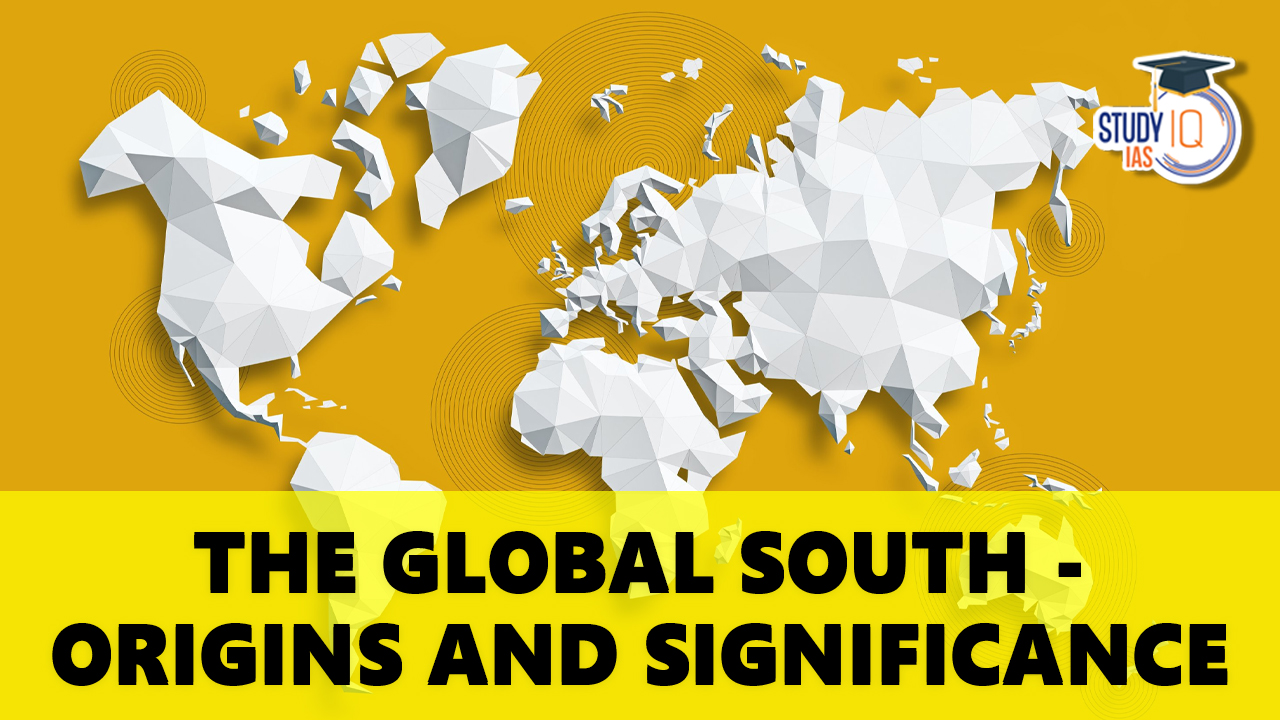Table of Contents
Context: As many leading countries in Africa, Asia, and Latin America have refused to stand with NATO over the war in Ukraine, the term “Global South” has once again in spotlight.
What is the Global South?
- The term “Global South” refers to countries that are often described as ‘developing’, ‘less developed’, or ‘underdeveloped’.
- It encompasses countries in Africa, Asia, and Latin America, which are characterized by higher levels of poverty, income inequality, and harsh living conditions compared to the “Global North”.
- ‘Global North’ refers to the developed countries like the US, Canada, Europe, Russia, Australia and New Zealand.

Origin of the Concept of Global South
- The term Global South was first used in 1969 by political activist Carl Oglesby, who argued that the war in Vietnam was the culmination of a history of northern “dominance over the global south.”
- But it was only after the 1991 breakup of the Soviet Union — which marked the end of the so-called “Second World” — that the term gained momentum.
- The three-world analogy was first coined by a French demographer Alfred Sauvy in 1952.
- First World: Referred to the advanced capitalist nations;
- Second World: Referred to the socialist nations led by the Soviet Union; and
- Third World: Referred to developing nations, many at the time still under the colonial influence.
- With the fall of the Soviet Union, which marked the end of ‘Second World’ — resulted in the decline of the usage of the term ‘Third World’ too.
- Additionally, criticisms arose regarding the negative connotations associated with the term “Third World,” which often portrayed developing nations as impoverished, unstable, and underdeveloped.
- To address these concerns and provide a more neutral and inclusive terminology, the term “Global South” emerged.
- The Brandt Line is a visual representation of the division between the Global North and the Global South based on economic disparities.
- It was proposed by the German statesman Willy Brandt in the 1980s and gained significant attention.
Important characteristics of the Global South
- Geopolitical, not geographical: The term ‘Global South’ is not geographical. In fact, the Global South’s two largest countries — China and India — lie entirely in the Northern Hemisphere. Rather, its usage denotes a mix of political, geopolitical and economic commonalities between nations.
- Colonial legacy: Countries in the Global South were mostly at the receiving end of imperialism and colonial rule, with African countries as perhaps the most visible example of this.
- Economic challenges: Many Global South countries face economic disparities, poverty, and a lack of infrastructure etc.
- Non-alignment and diverse alliances: Due to their historical experiences and the imbalanced relationships with the Global North, countries in the Global South often prefer not to align themselves strongly with any single global power. They may form alliances or pursue independent foreign policies based on their own interests.
Significance of the Global South
- Resource rich: ‘Global South’ is significant because of its large population, rich cultures, and abundant natural resources.
- Growing Economic Might: The economic prowess of the Global South has been increasing rapidly.
- By 2030 it is projected that three of the four largest economies will be from the Global South, with the order being China, India, the U.S. and Indonesia.
- Already the GDP in terms of purchasing power of the Global South-dominated BRICS nations — Brazil, Russia, India, China and South Africa — surpasses that of the Global North’s G-7 club. And there are now more billionaires in Beijing than in New York City.
- Increasing Political Visibility: This economic shift has gone hand in hand with enhanced political visibility.
- Countries in the Global South are increasingly asserting themselves on the global scene — be it China’s brokering of Iran and Saudi Arabia’s peace deal or Brazil’s attempt to push a peace plan to end the war in Ukraine.
Several Concerns within the Global South
- Economic Inequality: Many countries in the Global South still struggle with poverty and economic inequality, which can make it difficult to implement development initiatives.
- Political Instability: Political instability in many countries in the Global South can make it difficult to implement long-term development plans and can also create a hostile environment for foreign investment.
- Climate Change: Climate change is a growing concern in many countries in the Global South, as it can exacerbate existing poverty and inequality and create new challenges for development.
- Lack of Infrastructure: Many countries in the Global South lack basic infrastructure, such as roads, ports, and power, which can make it difficult to attract foreign investment and promote economic growth.
- Limited Human Capacity: Lack of skilled human resources and lack of education is one of the main challenges for development in the global south.
Initiatives for the South-South Cooperation
- BRICS Forum: BRICS is an association of five major emerging economies that includes Brazil, Russia, India, China, and South Africa. The forum promotes economic cooperation, political dialogue, and mutual support among its member countries.
- India, Brazil, and South Africa (IBSA) Forum: It aims to promote cooperation in various areas, including agriculture, trade, investment, science and technology, education, and social development.
- Group of 77 (G77): The G77 is a coalition of developing countries at the United Nations. The group promotes the interests and priorities of its member countries, particularly those in the Global South.
- International Day for South-South Cooperation: The United Nations observes the International Day for South-South Cooperation on September 12th each year. It commemorates the adoption of a plan of action by the United Nations General Assembly in 1978 to promote technical cooperation among developing countries.
India as the Voice of Global South
- Historical Perspective: India’s own history of colonialism and struggle for independence gives it a deep understanding of the challenges faced by countries in the Global South.
- Economic Growth and Development: As one of the fastest-growing major economies, India’s success story can serve as an inspiration for other developing countries.
- Multilateral Engagement: India actively participates in various international forums, including the United Nations, G20, BRICS, and IBSA, where it can articulate the concerns and priorities of the Global South.
- South-South Cooperation: India has been a strong proponent of South-South cooperation, emphasizing the importance of collaboration and mutual assistance among developing countries.
- Bridge between North and South: India’s foreign policy objective of bridging the gap between the Global North and the Global South positions it as a potential mediator and facilitator of dialogue.


 UPSC CDS 1 Final Result 2025 Declared: D...
UPSC CDS 1 Final Result 2025 Declared: D...
 Ramsar Sites in India 2025 List: Names, ...
Ramsar Sites in India 2025 List: Names, ...
 SEBI’s SWAGAT-FI Framework for Low-Ris...
SEBI’s SWAGAT-FI Framework for Low-Ris...

























